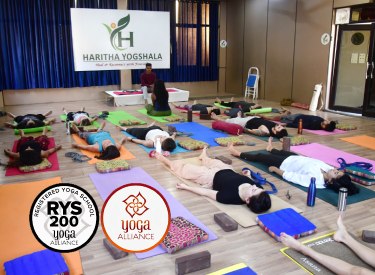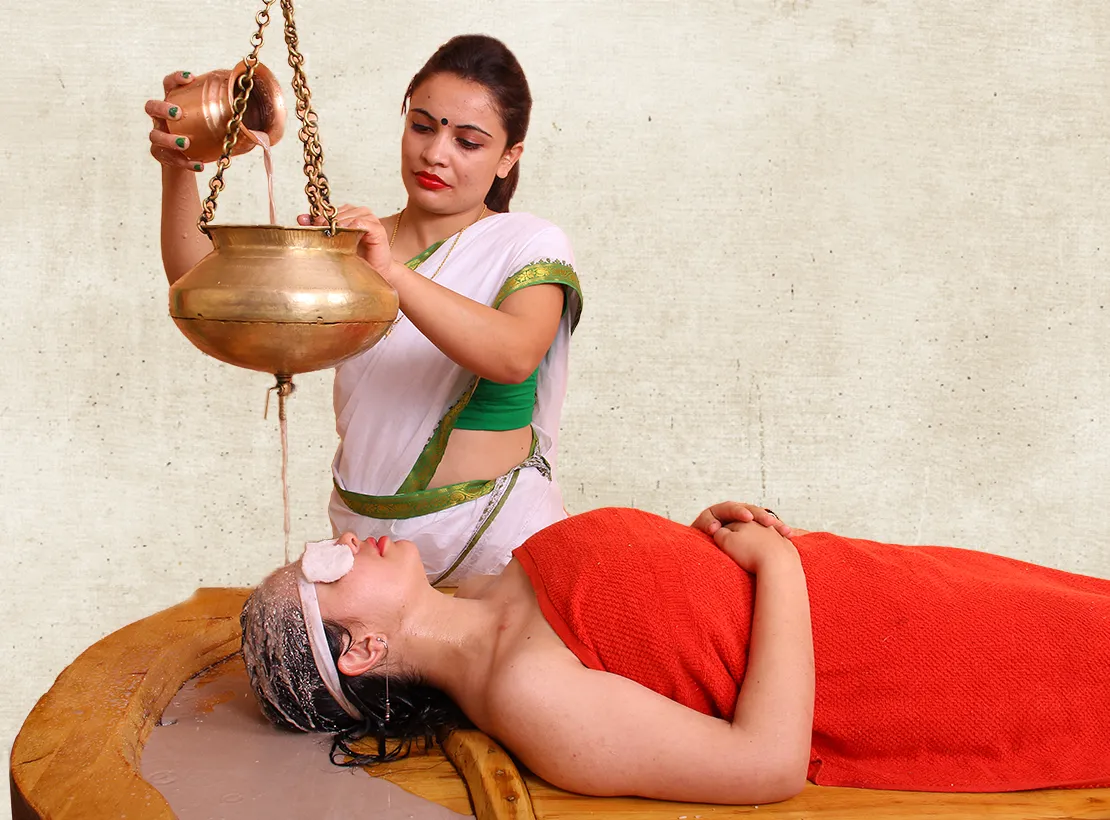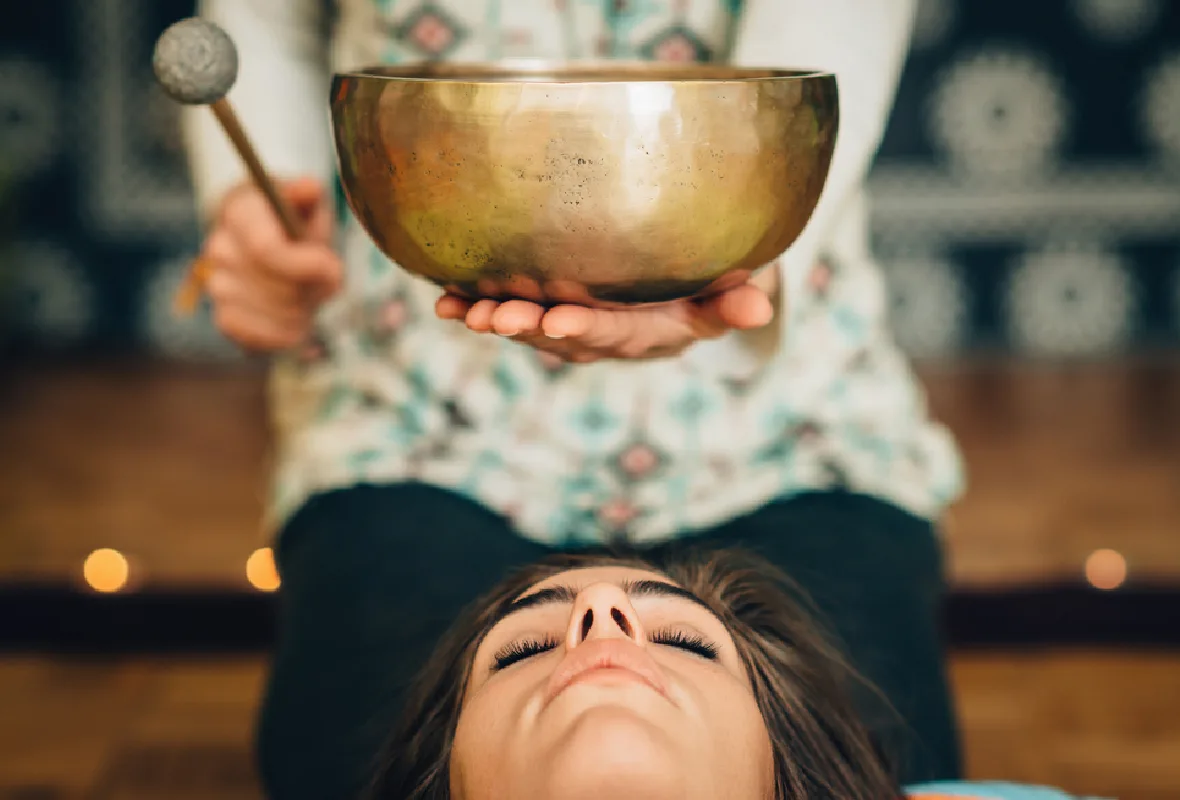
Ashtanga Namaskara is a yoga pose that is the 6th part of the Surya Namaskara (Sun Salutation) sequence. It is called Ashtanga because this asana involves 8 curved limbs to salute sun. It involves balancing the body on eight points of contact with the floor, including the hands, knees, chest, and chin or forehead. This pose offers a multitude of benefits for the body, mind, and spirit.
Create an image that shows the physical benefits of Ashtanga Namaskara, such as increased upper body strength and improved core stability. Use vibrant colors and bold lines to convey a sense of energy and power. Show the pose being performed by a person with perfect form and alignment, with their body straight and strong. Include visual elements that suggest a connection to nature, such as leaves or trees in the background, to emphasize the holistic benefits of this pose.
Ashtanga Namaskara is 6th step of surya namaskar.
It involves 8 curved limbs touching to the ground thus the name Ashtanga, i.e.,8.
Ashtanga namaskar is a beginner pose, that tests flexibility and balance
It's treats Diabetes Type II, High B.P, Mental illness, obesity, etc
Ashtanga Namaskara enhances body awareness, activates Manipura chakra, aids metabolism, and strengthens limbs and spin
Avoid this pose if you have certain medical conditions or injuries.
_1707292317.png)
Ashtanga Namaskara is a yoga pose that is often practiced as part of the Surya Namaskara sequence. It involves balancing the body on eight points of contact with the floor, including the feet, knee joints, chest, chin or forehead, and both hands. This pose acts as a warm-up for the body and prepares it for further activities. It is also a traditional pose that is used to pay respect to elders, gods, and sages. Ashtanga Namaskara is considered a beginner's pose that helps strengthen the arms and is a prerequisite for more advanced poses like Chaturanga Dandasana.
Ashtanga Namaskara is a fundamental yoga pose that forms part of the Surya Namaskara (Sun Salutation) sequence. It requires balancing the body on eight points of contact with the floor, thus providing a solid foundation for further movements and poses. By engaging multiple muscle groups and focusing on proper alignment, Ashtanga Namaskara helps to warm up the body and improve overall flexibility and strength.
This yoga pose is performed by starting in a high plank position, with the hands placed firmly on the ground and the body in a straight line. From there, the practitioner gradually lowers the knees, chest, chin, and forehead to the floor, while keeping the elbows close to the body. The eight points of contact with the ground are the feet, knees, chest, chin, and hands, which provide stability and support throughout the pose.
Ashtanga Namaskara is often used as a warm-up exercise at the beginning of a yoga practice. It helps to activate and awaken the body, preparing it for more challenging poses and movements. This pose also serves as a way to show respect and gratitude, with the eight points of contact symbolizing reverence for different aspects of life.
To perform Ashtanga Namaskara, follow these steps:
Start in the plank pose, with the shoulders directly above the wrists.
On an exhale, lower the knees to the floor.
Lower the chest to the floor, followed by the forehead or chin.
Keep the elbows hugged to the sides of the body and the toes tucked under.
Breathe smoothly throughout the pose.
Balance the body on the arms, chest, and knees.
Now chant the hymn 'Om Pushne Namaha' while in the pose.
To release from the pose, lift the chin off the ground.
Slide the chest through the hands.
Gradually arrive at Bhujangasana (cobra pose).
Note: It is important to maintain breath control and proper alignment throughout the pose.
Ashtanga Namaskara, also known as the Eight Limbed Pose, offers a multitude of health benefits that can enhance your overall well-being. This pose not only strengthens the arms and shoulders but also targets the biceps and triceps, promoting upper body strength and stability. By engaging the muscles in the abdomen, knees, and chest, Ashtanga Namaskara aids in building core strength and improving posture.
One of the significant advantages of this pose is its positive impact on the back and spine. Ashtanga Namaskara enhances the stability, flexibility, and mobility of the back, making it an effective practice for individuals experiencing backache. Additionally, this pose stretches the soles, toes, lower back, hips, and neck, relieving tension and promoting improved flexibility in these areas.
Moreover, Ashtanga Namaskara opens up the chest, which is beneficial for the health of the chest organs. This increased chest expansion helps in deepening the breath and enhancing lung capacity. By preparing the body for arm balancing poses like Chaturanga Dandasana, Ashtanga Namaskara builds the necessary strength and stability required for these more advanced postures.
Aside from the physical benefits, practicing Ashtanga Namaskara can also have a positive impact on the mind. The focus and concentration required in this pose help to calm the mind, promoting a sense of calmness and mindfulness. By incorporating Ashtanga Namaskara into your yoga routine, you can experience the holistic benefits it offers for both the body and mind.
Ashtanga Namsakar or Eight Limbed Pose yoga asana contributes to the treatment of several diseases. These are the chronic health issues that an expert yoga practitioner like Dhruv Sharma suggests to practice. One of the major diseases that is relieved with ashtanga namaskar yoga asana is Diabetes Type II. Studies show that this yoga asana helps in toning and massaging the endocrine glands and promotes insulin secretion by activating the pancreas and, thus, helps in managing diabetes naturally.
Another disease that is controlled by Ashtanga Namaskar is High Blood pressure: B.P problem is caused by the imbalance of diastolic and systolic blood pressure. With this asana, this pressure is reduced resulting in normal B.P.
Lung capacity: As the whole body is lying down with the help of curved limbs, the body needs to exert much higher pressure on the ground. This needs more energy to be produced by the body. As a result the capacity of the lung is automatically increases. Also, the benefit is multifold if you practice the pose with the chant "Om Pushne Namah".
Obese Body: As the body is fully constrained in the Ashtanga Namaskar yoga pose, the pose needs to exert high energy that is produced by burning the fat near the stomach area. Studies have also proved that the practice of surya namaskara resulted in a reduction in total cholesterol and triglycerides and an increase in high-density lipoprotein (HDLP). Thus, a daily practice of ashtanga namaskara, a part of Surya namaskara, manage the body's lipid profile.
| Health Benefits of Ashtanga Namaskara | Description |
|---|---|
| Strengthens Arms and Shoulders | This pose targets the muscles in the arms and shoulders, improving strength and stability in these areas. |
| Promotes Flexibility | Ashtanga Namaskara stretches various parts of the body, including the soles, toes, lower back, hips, and neck, thereby enhancing overall flexibility. |
| Relieves Backache | By improving stability, flexibility, and mobility of the back and spine, this pose helps alleviate backache and promote a healthy spine. |
| Enhances Chest Expansion | The opening up of the chest in Ashtanga Namaskara is beneficial for the health of the chest organs and improves lung capacity. |
| Prepares for Arm Balancing Poses | By strengthening the necessary muscles and promoting balance, this pose prepares the body for more advanced arm balancing poses. |
| Promotes Mindfulness | The focus and concentration required in this pose contribute to a sense of calmness and mindfulness. |
While practicing Ashtanga Namaskara can provide numerous benefits, it is important to take certain precautions to ensure a safe and effective practice. It is crucial to listen to your body and be mindful of any pain or discomfort that may arise during the pose.
If you experience wrist pain or have any wrist injuries, it is advisable to avoid practicing Ashtanga Namaskara. The pose involves placing weight on the hands, which can exacerbate wrist discomfort or cause further injury. Similarly, individuals with neck problems should exercise caution when performing this pose, as placing the chin or forehead on the floor may strain the neck.
Another precaution to consider is avoiding Ashtanga Namaskara if you have very high blood pressure. This pose can increase pressure in the upper body, potentially leading to spikes in blood pressure levels. If you are pregnant, it is recommended to refrain from practicing Ashtanga Namaskara after the first trimester, as the pose may pose risks to both the mother and the developing fetus.
Remember, practicing yoga should be a safe and nurturing experience. Always honor your body's limitations and modify or avoid poses that may cause discomfort or risk of injury. If you have any specific medical concerns or conditions, consult with a qualified yoga teacher or healthcare professional for personalized guidance.
| Precautions | Recommendations |
|---|---|
| Wrist Pain or Injuries | Avoid practicing Ashtanga Namaskara to prevent further discomfort or injury. Modify the pose by using yoga blocks or placing fists on the floor instead of palms. |
| Neck Problems | Exercise caution and avoid placing excessive strain on the neck. Use props like blocks or cushions to support the head in a comfortable position. |
| High Blood Pressure | Avoid practicing Ashtanga Namaskara to prevent potential spikes in blood pressure levels. Choose alternative poses that are more suitable for individuals with high blood pressure. |
| Pregnancy | Pregnant women should refrain from practicing Ashtanga Namaskara after the first trimester to ensure the safety of both the mother and the baby. Consult with a prenatal yoga instructor for appropriate modifications. |
By practicing Ashtanga Namaskara mindfully and with the necessary precautions, you can enjoy the numerous benefits of this pose while keeping your body safe and healthy.
Ashtanga Namaskara, a powerful yoga pose, has a profound impact on the doshas (energetic forces) and subtypes in the body. By activating Manipura Chakra (Solar Plexus), it balances samana vata and pachaka pitta, which are the doshas related to digestion. This activation helps in regulating and improving the digestive process, promoting optimal nutrient absorption and overall digestive health.
Furthermore, Ashtanga Namaskara also balances udana vata and avalambaka kapha, which are the doshas related to the chest. By opening up the chest in this pose, it encourages deep breathing, enhances lung capacity, and promotes respiratory health. This not only benefits the physical body but also has a calming effect on the mind, making it a beneficial pose for promoting mental and emotional well-being.
In addition to its impact on the doshas, Ashtanga Namaskara also balances the Prana Vata - Sadhaka Pitta - Tarpaka Kapha axis. This axis is responsible for regulating the flow of vital energy in the body, promoting harmony and overall wellness.
Ashtanga Namaskara not only offers these doshic benefits but also tones up, stretches, and strengthens the muscles of the arms, shoulders, and other body parts involved in the pose. Its holistic impact on both the physical and energetic aspects of the body makes it a valuable addition to any yoga practice.
"Ashtanga Namaskara balances the doshas related to digestion and chest, promoting optimal digestive health, respiratory well-being, and overall harmony in the body." Dr. Deepak (B.A.M.S.)
| Doshas | Impact of Ashtanga Namaskara |
|---|---|
| Samana Vata & Pachaka Pitta | Regulates digestion and improves nutrient absorption |
| Udana Vata & Avalambaka Kapha | Promotes deep breathing, lung capacity, and emotional balance |
| Prana Vata - Sadhaka Pitta - Tarpaka Kapha axis | Brings harmony and balance to the body and mind |
Ashtanga Namaskara, like any other yoga pose, can be modified to accommodate different needs and physical limitations. Here are some modifications and tips to consider for practicing Ashtanga Namaskara:
For individuals with neck problems or discomfort, it is recommended to place the chin on a block or cushion instead of directly on the floor. This modification helps to reduce strain on the neck and allows for a more comfortable practice.
If you experience wrist pain during Ashtanga Namaskara, there are a couple of modifications you can try. One option is to use yoga blocks and place your palms on them instead of directly on the floor. This helps to alleviate pressure on the wrists. Alternatively, you can make fists with your hands and rest your fists on the floor. This modification provides additional support to the wrists, reducing discomfort.
If you have lower back pain or any other injuries or conditions that may be aggravated by Ashtanga Namaskara, it is important to listen to your body and avoid this pose. Pushing through pain can lead to further injury or discomfort. Instead, focus on alternative poses that help alleviate lower back pain and consult with a qualified yoga teacher or healthcare professional for personalized modifications.
Remember to always prioritize safety and listen to your body when practicing Ashtanga Namaskara or any other yoga pose. Every individual is unique, and it's important to find modifications that suit your needs and limitations. With proper modifications and guidance, you can enjoy the benefits of this pose while ensuring a safe and enjoyable practice.
| Condition | Modification |
|---|---|
| Neck Problems | Place the chin on a block or cushion instead of directly on the floor |
| Wrist Pain | Use yoga blocks or make fists and rest them on the floor instead of placing the palms directly on the floor |
| Lower Back Pain | Avoid the pose if you have lower back pain or any other injuries or conditions that may be aggravated by the pose |
Always consult with a qualified yoga teacher or healthcare professional for personalized modifications and guidance based on your specific needs and limitations.
Breath control, or pranayama, plays a vital role in the practice of Ashtanga Namaskara. Deep breathing is encouraged throughout the pose, enabling practitioners to calm the mind and enhance the mind-body connection. By focusing on the breath and maintaining a steady breath rhythm, individuals can experience a heightened sense of relaxation and stress reduction.
The breathing technique employed during Ashtanga Namaskara can be viewed as a stress buster exercise. By incorporating breath control into the practice, individuals can further enhance the overall benefits of this pose, delving deeper into the mind-body experience.
There are several ways in which breath control contributes to the effectiveness of Ashtanga Namaskara:
Enhanced Mind-Body Connection: By consciously focusing on the breath, practitioners develop a deeper awareness of their physical sensations and mental state, fostering a stronger mind-body connection.
Promotes Relaxation: Deep breathing encourages a relaxation response in the body, allowing for a release of tension and stress. This can lead to a sense of calm and tranquility.
Stress Reduction: The steady breath rhythm maintained during the pose has a soothing effect on the nervous system, helping to alleviate stress and promote a sense of peace.
Increased Energy Flow: Mindful breathing facilitates the free flow of prana (life force energy) throughout the body, revitalizing both the physical and energetic systems.
Improved Focus and Concentration: Breath control helps to redirect the mind's attention, improving focus and concentration during the practice of Ashtanga Namaskara.
Incorporating breath control into your Ashtanga Namaskara practice can significantly enhance its effectiveness, allowing you to reap the full benefits of this empowering pose.
When practicing Ashtanga Namaskara, it is important to follow these tips to ensure a safe and effective practice:
Start with 2-5 breaths in the final position: As a beginner, it is recommended to hold the pose for 2-5 breaths. This allows your body to gradually build strength and familiarity with the pose.
Gradually increase the duration: As you become more comfortable with Ashtanga Namaskara, you can increase the duration of the pose. Aim to hold it for longer periods, striving for smooth transitions and proper form.
Repeat the pose 3-5 times: To reap the full benefits of Ashtanga Namaskara, incorporate multiple repetitions into your practice session. This allows you to engage different muscle groups and improve your overall stability and control.
Listen to your body: It is crucial to listen to your body throughout the practice. Never push yourself beyond your limits or force yourself into discomfort or pain. Modify the pose or take breaks as needed.
Practice with awareness, focusing on proper alignment and breath control.
Remember, each individual is unique, so adjust the duration and intensity of your Ashtanga Namaskara practice according to your own abilities and needs. Consulting with a qualified yoga teacher can provide personalized guidance and support.
Now, let's take a closer look at the recommended duration of Ashtanga Namaskara:
| Level | Duration |
|---|---|
| Beginner | 2-5 breaths |
| Intermediate | 6-10 breaths |
| Advanced | 11+ breaths |
Remember, these durations are just guidelines. Find a duration that challenges you without causing strain or discomfort. As you progress in your practice, you can gradually increase the duration to further enhance your strength and endurance.
Continue to practice Ashtanga Namaskara with dedication and patience, and you will experience the transformative benefits of this powerful yoga pose.
Ashtanga Namaskara, a yoga pose that forms part of the Surya Namaskara sequence, has a powerful effect on Manipura Chakra, which is located in the solar plexus area. This chakra plays a vital role in digestion and is responsible for activating the organs involved in the digestive process. By practicing Ashtanga Namaskara, you can stimulate and enhance the flow of energy in Manipura Chakra, thereby promoting healthy digestion and overall well-being.
The activation of Manipura Chakra through the practice of Ashtanga Namaskara is believed to have a positive impact on both the body and mind. When the energy in this chakra is balanced, it can help create a sense of harmony and balance within oneself. By focusing on this pose and its effect on Manipura Chakra, you can tap into the body's innate wisdom to support optimal digestion and foster a greater sense of well-being.
Enhancing the flow of energy in Manipura Chakra through Ashtanga Namaskara can have far-reaching benefits beyond digestion. This chakra is also associated with personal power, self-confidence, and transformation. By activating Manipura Chakra, you may experience a greater sense of inner strength and empowerment, enabling you to navigate life's challenges with confidence and grace.
To further illustrate the impact of Ashtanga Namaskara on Manipura Chakra, we can observe its effect on related aspects of the body-mind system:
| Ashtanga Namaskara | Manipura Chakra |
|---|---|
| Stimulates and balances | Activates and supports healthy digestion |
| Enhances Prana (life force) flow | Influences personal power and self-confidence |
| Brings balance and harmony | Fosters transformation and growth |
| Strengthens mind-body connection | Facilitates a sense of inner strength |
| Promotes overall well-being | Encourages balance and vitality |
By recognizing the interconnectedness of Ashtanga Namaskara and Manipura Chakra, you can harness the potential power of this yoga pose to promote optimal digestion, personal growth, and overall wellness. Incorporate this pose into your practice and explore the transformative effects it can have on your body, mind, and spirit.
Read Also: Benefits Of Bhadrasana Yoga (Butterfly Pose) & How To Do It? - A Step-by-Step Guide
Ashtanga Namaskara is a powerful yoga pose that offers tremendous amount of benefits for the whole body and mind. By incorporating this pose into your practice, you can strengthen your arms and shoulders, improve flexibility and posture, and relieve backache. Additionally, Ashtanga Namaskara cultivates a deep sense of body awareness, allowing you to connect with your physical self on a profound level.
Furthermore, Ashtanga Namaskara serves as a foundation for more advanced arm balancing poses, making it an integral part of any yoga practice. By strengthening your arms and developing core stability, this pose prepares you for more challenging postures, enhancing your overall physical capabilities and allowing for further growth on your yoga journey.
Incorporating Ashtanga Namaskara into your routine can bring about a holistic transformation, supporting your wellness goals both on and off the mat. By reaping the benefits of this empowering pose, you can cultivate strength, flexibility, mindfulness, and a more balanced lifestyle.
Hope you find this article helpful and knowledgeable. If you want to learn complete yoga you can connect with us via info@harithayogshala.com. If you're new to yoga and want to start practicing yoga in an organised way to learning the correct techniques for yoga asanas, our Yoga for Beginners course is the ideal choice for you.
Explore our 100-hour Yoga Teacher Training course, offered by one of the best training facilities in Rishikesh, perfect for those interested in deepening their practice and teaching skills.
Explore the world of healing and meditation through our exceptional Sound Healing course in Rishikesh.Designed for people who are passionate about learning and engaging with these activities that change lives
All the best for healthy living!


Haritha offers 100, 200, 300 hours yoga teacher training in Rishikesh


Know about Haritha healing and meditation courses and therapies
